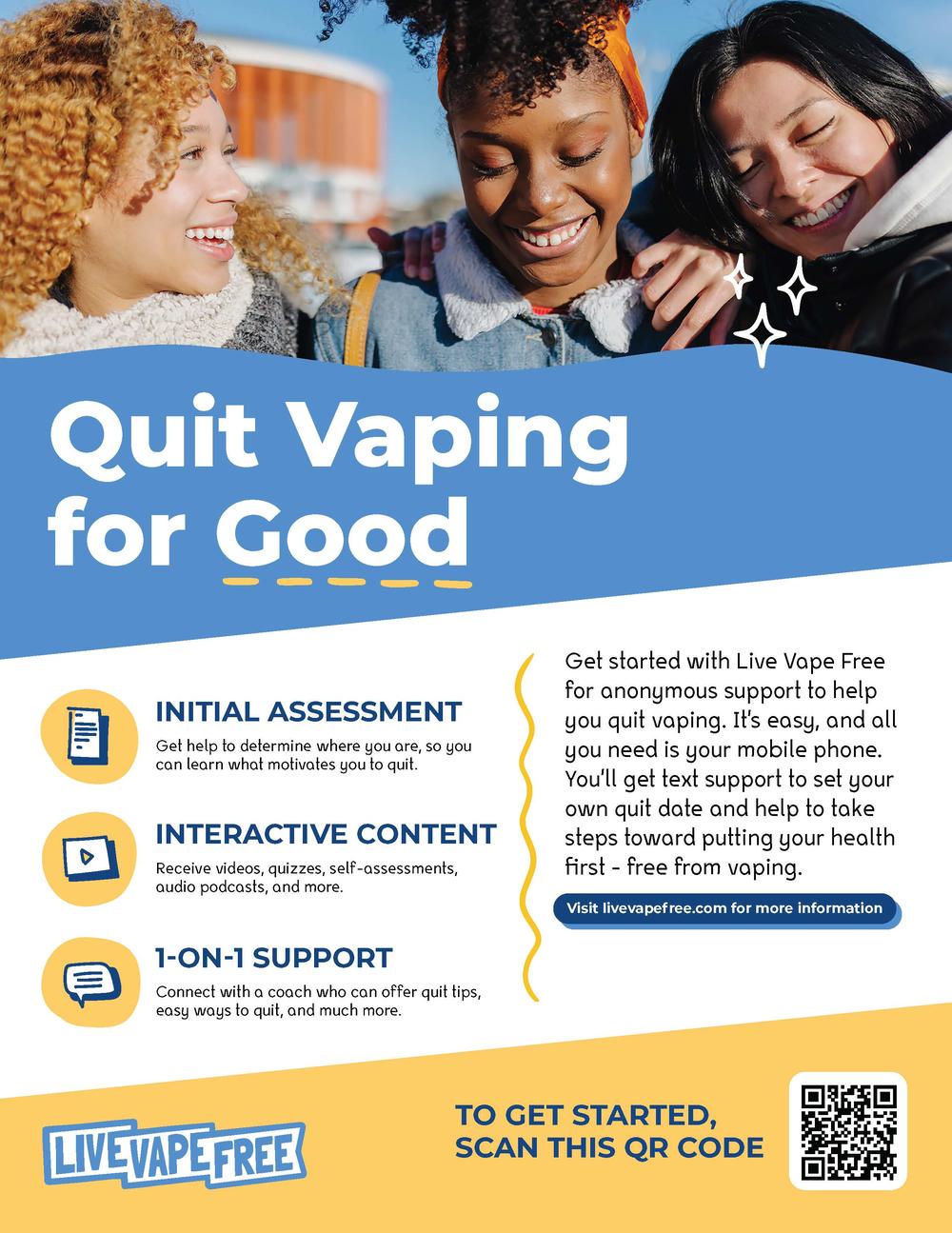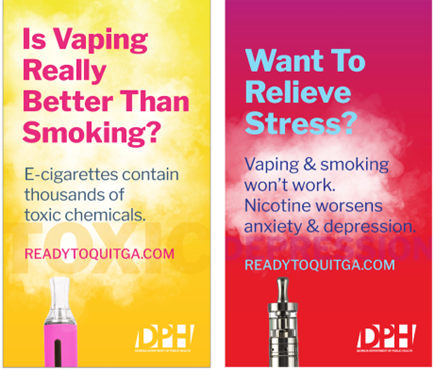
E-Cigarettes (Vapes)

The Truth About E-cigarettes (Vapes)
Electronic cigarettes (e-cigarettes) and other vapor products are used to heat and aerosolize (turn into particles) liquid known as e-juice (vape juice) containing highly addictive nicotine or other substances that a person can inhale into their lungs. The use of these products is commonly referred to as "vaping."
E-cigarettes come in many different forms. Most are noncombustible and include a battery, a heating element, and a liquid compartment, usually containing addictive nicotine, that is added to the e-liquid or included in the device. The heating element aerosolizes the liquid for the inhalation of the liquid nicotine or other contents. E-cigarettes are known by many different names, including "vapes," "e-cigs," “puff bars,” and "electronic nicotine delivery systems (ENDS)."
Other electronic vapor products that use e-liquids include e-cigars, e-pipes, and hookah pens (e-hookah).
Youth and Young Adult Vaping is Popular and Harmful!

Vapes come in colorful, fun, and unique product designs, along with many flavors, all of which come together as part of the attraction for youth who believe that these products are not addictive and are safe to use. Many users believe vaping will reduce stress, anxiety, and depression. Vapes are often viewed and marketed as a safe alternative to smoking.
Most vapes contain high levels of nicotine (synthetic and tobacco derived), which is very addictive, impacts youth and young adult brain development, can lead to increased stress or mood disorders, and can lead to cigarette smoking or other drug addictions over time.
Vape aerosols are not just harmless water vapors that are inhaled and exhaled (as marketed). Vape aerosol exposure is unsafe and contains chemicals, metals (i.e., lead, nickel), and other particles that can interfere with lung development and health. Vape aerosols may also increase the risk of heart disease, lung cancer, and asthma complications.
Vaping is illegal for anyone under the age of 21.
It shall be unlawful for any person to:
- Sell or barter any of the prohibited products to individuals under 21 years.
- Purchase any of the prohibited products for individuals under 21 years.
- Advise, counsel, or compel individuals under 21 years to use any of the prohibited products.
Any person that violates this law shall be guilty of a misdemeanor!

Schools can utilize the supportive prevention programs to educate and prevent tobacco use among elementary, middle, and high school students. These programs were evaluated using the approved K-12 Georgia Standards of Excellence for Health Education by the Georgia Board of Education. The Georgia Tobacco Use Prevention Program created a rubric of vaping prevention programs including the number of program sessions, length and additional resources provided by the programs. The programs included in this rubric is not an exhausted list of vaping prevention programs.
Click
HERE
to view the vaping prevention program rubric.
Catch My Breath created by Coordinated Approach to Child Health (CATCH)
The CATCH My Breath (CMB) core curriculum for grades 5-12 is an evidence-based youth nicotine vaping prevention program developed in response to the youth vaping epidemic. It also develops general critical thinking and refusal skills that empower youth to make responsible decisions about all kinds of harmful substances.
Reaching beyond the evidence-based core curriculum, the expansion lessons enable schools to provide a comprehensive substance misuse education starting in kindergarten. Lessons for grades K-4 are included in this section as research has demonstrated that early prevention is the only effective deterrence of substance abuse in high school students and that introducing instruction in this area starting in early elementary school will reduce the impact of substance misuse.
Website: CATCH My Breath
Vaping: Know the Truth created by Truth Initiative
Vaping: Know the truth is a new national youth vaping prevention curriculum created by Truth Initiative and Kaiser Permanente, in collaboration with the American Heart Association, to educate students about the dangers of e-cigarette use. This free digital learning experience was developed as part of Truth Initiative’s nationally recognized truth campaign. In addition to encouraging students to live vape-free lives, this self-led interactive curriculum offers resources to help young people who are currently using e-cigarettes to quit through Truth’s first-of-its-kind text message quit vaping program This is Quitting, which is already helping over 400,000 youth and young adults on their journeys to quit.
Website: Vaping: Know the truth
ASPIRE (A Smoking Prevention Interactive Experience)
A Smoking Prevention Interactive Experience is a free, bilingual, online curriculum, fully aligned with National Education Standards, as well as with 21st Century Skills, that helps middle and high school teens learn to be tobacco free while explaining the dangers of tobacco and nicotine use. In this latest version, students travel through interactive modules and complete quizzes. They will hear testimonials from former smokers, health care professionals and cancer survivors.
Website: ASPIRE
Vaping Prevention & Education Resource Center
The Vaping Prevention and Education Resource Center is an online resource center of science-based, standards-mapped materials that teachers can use to help their students avoid vaping and nicotine addiction. The resource center features numerous age-appropriate, cross-curricular resources for teachers and parents to promote learning and begin having open conversations about youth vaping and tobacco use.
In addition to content designed for teachers, FDA also developed materials for parents and teens. All content at the resource center is free, easy to navigate, and optimized for each audience.
Teachers will find lesson plans, interactive tools, infographics, and videos with vaping facts and tips about how to teach teens about the dangers of e-cigarette use.
Parents will find fact sheets, videos, and resources to help them understand and recognize vapes, talk with their children, and keep the conversation going over time.
Students will find real-life stories and relatable content to help them understand vaping, nicotine addiction, common myths about e-cigarettes, and how to say "no" to vaping.
Website: Vaping Prevention and Education Resource Center
Know the Risks: A Youth Guide to E-cigarettes Presentation
CDC’s Office on Smoking and Health (OSH) developed this presentation to educate youth on e-cigarettes, including the health risks, the factors that lead to e-cigarette use, and what youth can do to avoid all tobacco products, including e-cigarettes. This resource is intended for adults who educate or serve youth ages 11 – 18 (teachers, youth ministers, coaches, scout leaders, etc.). Utilizing the talking points and information for users document, the presenter does not require additional information, nor permission to deliver the presentation.
Website: Know the Risks: A Youth Guide to E-cigarettes
Stanford Tobacco Prevention Toolkit
The You and Me, Together Vape-Free curriculum includes a middle and high school program that are 6 lessons, approximately 50 minutes each. It also includes a two-lesson elementary school version, approximately 50 minutes each. Every lesson provides activities, online quiz games, and worksheets in addition to presentations, resources, and other materials aimed at addressing key factors associated with youth e-cigarette use, including changing adolescents’ attitudes towards and misperceptions about e-cigarettes; increasing their refusal skills to pulls of flavors, marketing, and social media; reducing stress and depression which have been linked to e-cigarette initiation and use; improving coping; and decreasing intentions and actual use of all e-cigarette products.
These 6 in-class sessions are reinforced outside of the classroom with follow-up discussion guides that provide open-ended questions and activities for youth to discuss various e-cigarette-related topics with a trusted adult and/or peer in order to open dialogue between youth and adults. The curriculum is meant to reach all youth, including those at highest risk of tobacco use, racial/ethnic minorities, students in continuation and alternative schools, and those identifying as LGBTQ+.
Website: Standford Tobacco Prevention Toolkit

- Set a good example by being tobacco-free and ensure that your child is not exposed to secondhand smoke from any tobacco products, including e-cigarettes. If you use tobacco or vape, it is never too late to quit. Call the Georgia Tobacco Quit Line at 1-877-270-7867.
- Talk to your child or teen about why e-cigarettes are harmful to them. It’s never too late.
- Let your child know that you want them to stay away from all tobacco products, including e-cigarettes because they are not safe for them. Seek help, check in, and get involved.
- Set up an appointment with your child’s healthcare provider so that they can hear from a medical professional about the health risks of tobacco products, including e-cigarettes.
- Speak with your child’s teacher and school administrator about enforcement of tobacco-free school grounds policies and tobacco prevention curriculum.
- Encourage your child to learn the facts and get tips for quitting tobacco products at LIVEVAPEFREE.com
- Get the Talk With Your Teen About E-cigarettes tip sheet for parents. Start the conversation early with children about why e-cigarettes are harmful to them.
Know the signs of vaping, these include but are not limited to the following:
- A sweet, fruity, or minty smell.
- Always thirsty or have a dry mouth.
- Often make excuses to go to the bathroom or outside during family time.
- Frequent cough and/or nose bleeds.
- Change in mood like being more irritable or anxious.
- Change in eating habits.

- Georgia’s 24/7 text support for quitting vape
- Georgia Tobacco Quit Line for youth and young adults who use tobacco and vape
- American Lung Association Helping Teens Quit
- CDC Resources to Help Youth Reject or Quit Vaping
Quitting is your best option to reduce your risk from smoking and tobacco use-related diseases. Vaping is not a healthy alternative to smoking. E-cigarettes and vape products are not FDA-approved cessation devices. For more information and support to help you quit contact the Georgia Tobacco Quit Line.
Click HERE for more information about quitting.
Last Updated 10/29/2024